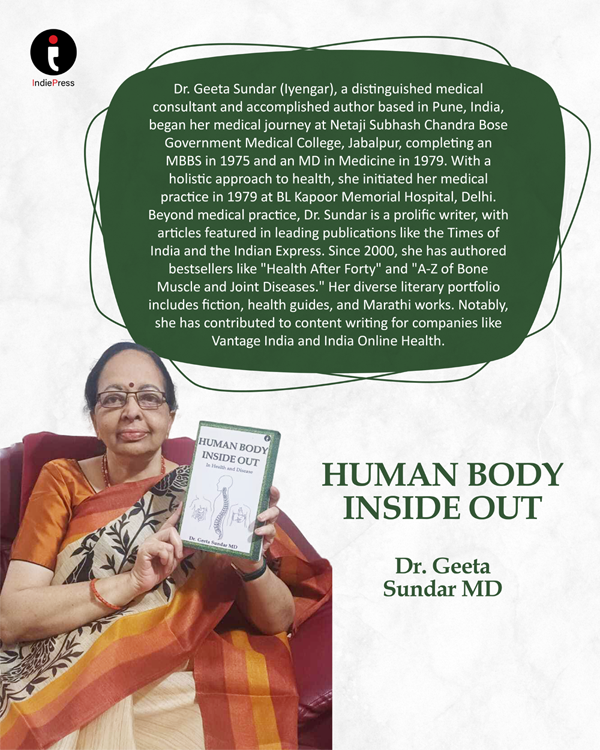The human body is a marvel of nature—an intricate, self-sustaining system that has evolved over billions of years. Yet, despite the incredible advancements in medical science, many of us lack a fundamental understanding of how our bodies function. Human Body Inside Out serves as an enlightening guide, unraveling the mysteries of human anatomy, physiology, and disease in a way that is easy to grasp. Dr. Geeta Sundar, with her decades of medical expertise, presents an invaluable resource for anyone looking to enhance their knowledge of health, disease prevention, and overall well-being. This book is a must-read for individuals, paramedical professionals, and even medical practitioners seeking a reliable reference.
1. What specifically qualified you to write this book, and what life experiences or knowledge do you bring to the subject?
The idea for this book emerged from conversations with my patients and acquaintances who expressed the need for a well-structured guide to understanding the human body—its appearance, functions, and complexities—explained in simple, accessible language. Having written books on health and fiction since 2000, and with 45 years of experience as a medical consultant, I felt well-equipped to fulfill this need by crafting a book that offers clarity on this fascinating subject.
2. Could you give a brief synopsis of your work and how it tackles the most important issues facing the modern world?
Human Body Inside Out is a detailed yet accessible resource designed to enhance readers’ understanding of the human body’s inner workings. More than just an informative book, it empowers individuals to make well-informed health decisions.
The book is also an essential tool for paramedical professionals, including physiotherapists and nurses, and even serves as a ready reference for medical practitioners. I have carefully integrated anatomy (structure), physiology (functions), and pathology (disease) to provide a well-rounded understanding of the body. Additionally, I have explored the complexities of the human mind, a subject that remains enigmatic even within the medical community.
For those interested in a deeper dive, I have included molecular biology—focusing on cellular, atomic, and genetic structures—catering to curious readers who wish to explore the body at a microscopic level. The human body is one of the most intricate creations of nature, and no single individual can claim to completely comprehend its complexities within a lifetime. However, I have strived to present this knowledge in a straightforward and engaging manner.
The human body operates much like a highly sophisticated, automated machine, with each organ system playing a crucial role while relying on the functionality of others. While we often emphasize the importance of the brain and heart, they cannot function without the kidneys, lungs, and liver. Even at the cellular level, each unit of life is self-contained and plays a role in the body’s overall function.
External factors influence our health in ways beyond our control. Inherited genes may predispose us to conditions such as short stature, obesity, cancer, diabetes, and hypertension. Additionally, environmental factors and lifestyle choices significantly shape our health. I illustrate this concept through an analogy: imagine ten individuals releasing oil lamps into a river. Each lamp has slight differences in weight, oil content, and wick size (representing genetic traits), which influence how they float. External elements such as water currents, obstacles, or wind may further alter their paths, leading some to drift smoothly while others extinguish or capsize. This mirrors how our genetics and environmental influences interact to determine our health outcomes.
In today’s fast-paced world, maintaining good health is increasingly challenging. Books like Human Body Inside Out are invaluable in preventing and managing diseases by equipping readers with scientific knowledge on health and wellness.
3. Could you list a few of the most important lessons or revelations that readers should anticipate from your book?
I hope readers will take away the following key insights:
- A newfound appreciation for the human body as an extraordinary creation that has evolved over four billion years.
- An understanding of the significance of preventive measures in delaying the onset of lifestyle diseases.
- A reliable reference guide to comprehend diseases before they occur and manage them effectively when they arise.
4. Which of your book’s case studies or real-world examples best exemplify the concepts you discuss?
Several real-life examples in the book highlight critical health concepts. For instance:
- In the chapter on heart health, I share the story of two patients experiencing heart attacks. One, who relied solely on a single doctor’s intervention, did not survive. The other, who was rushed to the hospital immediately, was saved. This underscores my advice: “In an emergency, call an ambulance, not a doctor!”
- I emphasize the importance of consistency in managing lifestyle diseases like diabetes, hypertension, obesity, and cardiovascular issues—highlighting regularity in diet, exercise, sleep, and medical checkups.
- The chapter on bronchial asthma stresses a crucial point: if an asthmatic patient turns blue, immediate hospitalization is necessary.
- I explore the detrimental effects of chronic stress and sleep deprivation on overall health.
- The chapter on constipation discusses the importance of responding to the body’s natural urges. Ignoring the early morning defecation reflex (mass reflex) can lead to chronic constipation and severe complications such as piles, fissures, hernias, and fistulas.
These are just a few examples of how the book provides actionable knowledge to enhance health and well-being.
5. When creating this book, did you face any special difficulties or barriers? If so, how did you get beyond them?
Writing this book was a monumental task that spanned 12 years. Compiling vast amounts of medical information and presenting it in a clear, simplified manner required meticulous effort. Covering the entire human body was no small feat, but by taking a patient and systematic approach, I was able to accomplish it.
6. What benefits do you think readers will derive from your work, and how will it positively affect their lives in your opinion?
This book serves as a practical guide for anyone seeking knowledge about the human body—whether a specific organ or its complete structure. Understanding the science behind bodily functions empowers individuals to take control of their health, fostering better disease prevention and overall well-being.
7. In an ever-evolving world, how can a book remain current and flexible for readers throughout time?
This is an essential consideration for any health book. While advancements in medical research, particularly with AI, continue to expand our understanding of the human body, the fundamental principles of anatomy and physiology remain unchanged. To keep the book relevant, I plan to update and revise it every five years, ensuring that readers always have access to the latest medical insights.
A Must-Read for Anyone Curious About Their Health!
Human Body Inside Out is more than just a medical reference—it is a gateway to understanding the incredible machine that is our body. Whether you are a student, a professional, or simply someone interested in health, this book will help you appreciate and care for the most extraordinary creation of all—the human body.
Grab your copy today on amazon and take charge of your well-being!



